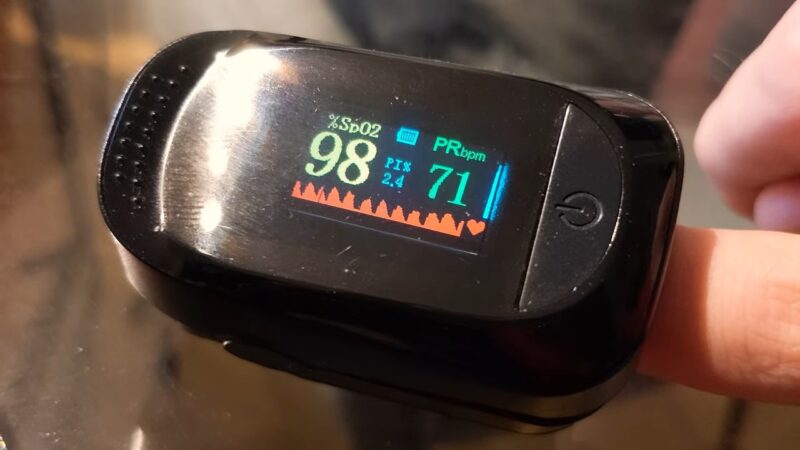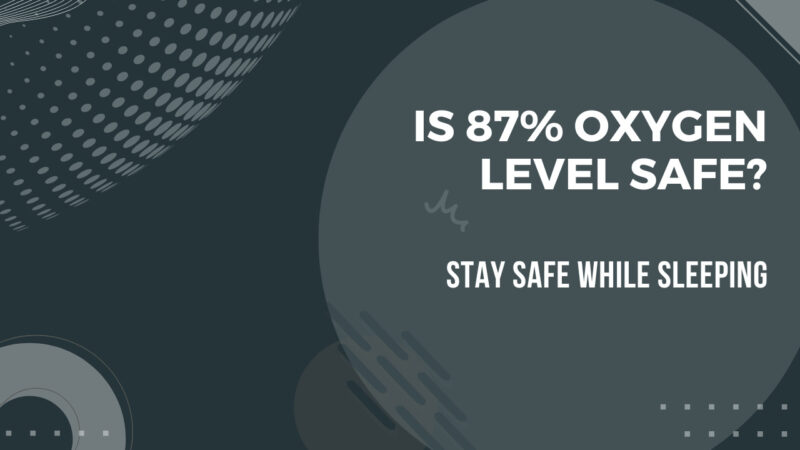Our bodies are amazing machines that continually adapt to changing conditions, one of which is oxygen availability. When we sleep, our bodies still require a steady supply of oxygen for vital processes.
But, what happens if our oxygen levels fall, say to 87% while we’re fast asleep? This is not a trivial question; it has implications for our overall health, sleep quality, and even life expectancy.
Oxygen Saturation in a Nutshell
Before we jump into the main topic, let’s clarify what we mean by oxygen saturation. Oxygen saturation (SpO2) is a measure of how much oxygen the blood is carrying as a percentage of the maximum it could carry. The oxygen saturation level tells us how effectively our body is gathering oxygen from the air.
In healthy adults, oxygen saturation levels typically fall between 94% and 99%. When levels drop below this range, it’s known as hypoxemia, a condition that can lead to severe health problems if left untreated.
Is 87% Oxygen Level Safe?
If your oxygen level falls to 87% while you’re asleep, is that safe? The short answer is: not ideally. Oxygen saturation levels at 87% are below the normal range for healthy individuals, which may suggest underlying health issues, most commonly associated with conditions like chronic obstructive pulmonary disease (COPD), sleep apnea, or other lung diseases.
Potential Causes of Lowered Levels
Hypoxemia during sleep can have various causes. Here are some of the most common:
- Sleep Apnea: Sleep apnea is a serious sleep disorder that causes interruptions in breathing during sleep. It can significantly reduce oxygen saturation levels and, if left untreated, can lead to heart disease, stroke, and other serious health conditions.
- COPD: Chronic obstructive pulmonary disease (COPD) is a chronic lung condition that affects airflow and makes it hard to breathe. People with COPD often experience lower-than-normal oxygen saturation levels, both when awake and asleep.
- Altitude: The higher the altitude, the less oxygen is available in the air. This can lead to lower oxygen saturation levels, especially during sleep when breathing naturally slows.
- Obesity: Excessive body weight can lead to reduced lung volume and obstructed breathing, leading to lower oxygen levels during sleep.
Risks Associated with Low Oxygen Saturation

Extended periods of reduced oxygen saturation, such as a SpO2 level of 87%, can lead to various health complications:
- Heart complications: Prolonged low oxygen levels can cause an increase in blood pressure in the lungs, a condition known as pulmonary hypertension. Over time, this can lead to heart failure.
- Brain Damage: Chronic hypoxemia can result in memory loss, difficulty concentrating, and other cognitive impairments due to the lack of sufficient oxygen supply to the brain.
- Polycythemia: To compensate for low oxygen levels, your body might produce more red blood cells. This condition, known as polycythemia, can increase the risk of blood clots, stroke, or heart attack.
Diagnosing and Managing Levels
If you suspect you have low oxygen levels during sleep, it’s crucial to seek medical attention. Sleep studies, also known as polysomnography, can measure your oxygen levels while you sleep, and other tests like arterial blood gas tests can provide additional data.
The management of low oxygen saturation during sleep typically involves treating the underlying condition. For sleep apnea, this might mean using a continuous positive airway pressure (CPAP) machine. For COPD, treatments may involve medication, oxygen therapy, or pulmonary rehabilitation.
Sleep Quality and Oxygen Saturation
Sleep is a fundamental biological process that allows our bodies to rest, repair, and rejuvenate. Each stage of sleep, from light sleep to deep sleep and REM sleep, plays a crucial role in maintaining our health and well-being. Oxygen plays a critical part in this process by providing the necessary fuel for these restorative functions.
When our oxygen levels drop during sleep, it can disturb the natural sleep cycle. For example, those with sleep apnea often experience repeated awakenings (even if they don’t remember them), preventing them from reaching or maintaining the deeper, more restful stages of sleep.
Over time, sleep deprivation can lead to daytime fatigue, irritability, and cognitive impairments. It also increases the risk of serious health conditions, including diabetes, obesity, depression, and cardiovascular disease.
Improving Oxygen Levels During Sleep

If you’re worried about your oxygen levels during sleep, there are steps you can take to improve them. Always consult with a healthcare provider first, but here are a few general tips:
- Healthy Lifestyle: A balanced diet and regular exercise can improve your lung health and overall oxygen levels. Exercise strengthens the lungs and heart, while a balanced diet provides the necessary nutrients for optimal body function.
- Optimize Sleep Environment: Your sleep environment can significantly affect your oxygen levels. For instance, a well-ventilated room can help ensure a sufficient supply of oxygen. Consider using an air purifier to reduce pollutants and allergens that might interfere with your breathing.
- Body Position: Believe it or not, your sleep position can influence your oxygen levels. Research suggests that sleeping on your side can help maintain higher oxygen saturation levels, particularly for those with sleep apnea.
- Quit Smoking: Smoking damages the lungs, reducing their capacity to absorb oxygen. If you’re a smoker, quitting can significantly improve your oxygen saturation levels, not to mention countless other health benefits.
Oxygen Concentrators and Sleep
For those with chronic conditions that lead to low oxygen saturation, supplemental oxygen during sleep may be necessary. In some cases, moderate sedation, a medical procedure that uses medication to help patients relax or sleep during diagnostic or therapeutic procedures, might be required.
This procedure has seen some significant coding and reimbursement changes in recent years. One common method is through an oxygen concentrator, a device that takes in air, removes gases like nitrogen, and delivers purified oxygen.
Keep in mind that while these devices can be highly effective, they should only be used under the supervision of a healthcare provider.

Diving Deeper
As we further explore the topic of oxygen levels during sleep, it’s important to understand the nuanced role that age plays in oxygen saturation. As we age, our respiratory function changes, which can impact our oxygen levels and sleep patterns.
Age and Oxygen Saturation
From infancy to older adulthood, our oxygen levels can fluctuate for various reasons. For example, it’s common for newborns to have slightly lower oxygen saturation levels, usually around 93%-94%, which gradually increase to the typical adult range of 95%-99% as the lungs mature.
In older adults, however, oxygen levels can decrease due to age-related changes in lung function, such as reduced lung volume and elasticity. Therefore, an oxygen saturation level of 87% while sleeping, although generally not considered safe at any age, could potentially be more common and more dangerous in older adults.
Sleep Architecture and Aging
Sleep architecture, or the structure and pattern of sleep stages, also changes as we age. Older adults often experience disruptions in sleep architecture, such as decreased REM and slow-wave sleep (deep sleep).
Coupled with lower oxygen levels, these changes can exacerbate the impact of sleep disturbances, leading to increased daytime sleepiness, mood changes, and reduced cognitive function.
Addressing Age-Related Oxygen Saturation Changes
While some decrease in oxygen saturation and sleep quality can be part of the normal aging process, significant drops in oxygen levels (such as to 87%) should not be ignored. Here are some age-specific considerations for managing oxygen levels:
Regular Health Check-ups
Regular medical screenings can help detect potential issues early, including those that might affect oxygen levels, such as COPD or heart disease.
Pulmonary Rehabilitation
In some cases, especially those with lung conditions, pulmonary rehabilitation can help. This is a program of exercise, education, and support to help patients breathe and function at the highest possible level.
Medication Management
Older adults often take multiple medications, some of which can affect sleep or breathing. Regular medication reviews can help identify any potential problems or interactions that might be affecting sleep or oxygen levels.
Assistive Devices
For severe sleep apnea or other conditions that cause significant drops in oxygen saturation, devices such as CPAP machines or oxygen concentrators may be beneficial.
Final Words
Oxygen saturation is a critical aspect of our health, playing an indispensable role during sleep. While a drop in oxygen levels to 87% isn’t typically considered safe, several methods can help improve oxygen saturation, ensuring a restful night’s sleep and a healthier life.
Always remember your health journey is unique, and while knowledge is powerful, it should never replace professional medical advice. Stay informed, stay proactive, and sleep well.

